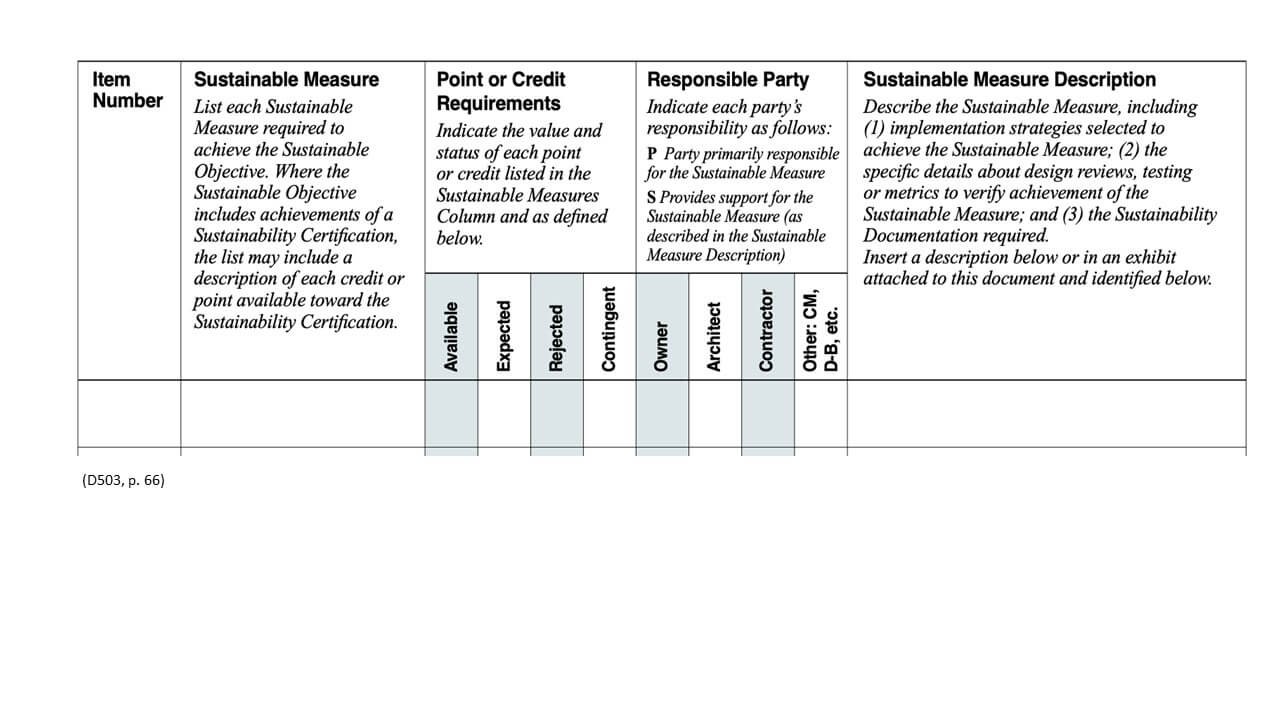Access the B101–2017, D503-2020, and E204–2017
To purchase a one-time use license for the documents in this article, visit the links below:
B101- 2017 Owner-Architect Agreement
D503–2020 Guide for Sustainable Projects
E204-2017 Sustainable Projects Exhibit
Interested in getting unlimited access to our full 250+ library of agreements and forms?
Visit the link below to learn more: https://shop.aiacontracts.com/unlimited-subscription
October 12, 2023
Projects pursuing sustainable outcomes can face increased risk due to various factors. Thankfully, there are a variety of tools that project teams can use to help manage these risks, including a Sustainability Plan.
A Sustainability Plan is a relatively short, but important risk management tool. It is a roadmap for achieving specified Sustainable Objectives, which outlines roles, responsibilities, and key deadlines. A good Sustainability Plan will address many of the issues that are especially relevant to sustainable projects, and clarify issues that led to some of the first cases of “green” building litigation.
How does a Sustainability Plan fit into the Contract Documents?
For any project pursuing sustainable outcomes, a good starting point is D503–2020 Guide for Sustainable Projects . D503, which was first released in 2011 and most recently updated in 2020, provides additional context and outlines considerations and contract documents that provide support for projects targeting sustainable outcomes.
Utilizing the guidance provided in D503, parties will often begin with B101- 2017 Owner-Architect Agreement, where the Owner and Architect state the Owner’s Sustainable Objective. If there is an agreed Sustainable Objective, the Owner and Architect further agree to complete E204-2017 Sustainable Projects Exhibit , and incorporate it into their Agreement. Sustainable Objectives vary by project, but often include third-party certification or achievement of a government incentive. Clearly outlining the Sustainable Objective is the first step to making sure all parties are working towards the same outcome(s).
E204 then requires the Architect to hold a Sustainability Workshop, to clarify various project aspects. After the workshop, the Architect develops the Sustainability Plan, which outlines the results of the Workshop. At a minimum, the Sustainability Plan should outline all the Sustainable Measures the project will need to complete in order to achieve the Sustainable Objective.
It is important to note that E204 references the Sustainability Plan and incorporates it into the Contract Documents by definition. (“The Sustainability Plan is a Contract Document that identifies and describes….” Section 1.2.3.). Incorporating E204 into the Contract Documents ensures the requisite level of formality and accountability is allocated to the Sustainability Plan and achieving the Sustainable Objective.
The strength of the Sustainability Plan originates from the fact that it requires the project team to clearly outline each step in the process (Sustainable Measure) and delineate the party, or parties, responsible for each Sustainable Measure. From a practical standpoint, the responsible party should be the party in the best position to perform that Sustainable Measure, and manage any associated risk.
What makes a good Sustainability Plan?
The Sustainability Plan is all the puzzle pieces necessary to achieve the Sustainable Objective. A Sustainability Plan includes some narrative text, but most of the information usually takes the form of a chart or Excel file. And, while parties often start with a template, each project is different, and, just like any other Contract Document, a Sustainability Plan should be carefully reviewed and revised for each project.
Generally speaking, the Sustainability Plan should include:
- Sustainable Objective
- Sustainable Measures
- Implementation strategies designed to achieve the Sustainable Measures
- Owner, Architect and Contractor roles and responsibilities with respect to achieving each Sustainable Measure
- Specific details regarding design reviews, testing or other metrics to verify achievement of each Sustainable Measure
- Sustainability Documentation required for the Project, third-party certification or any government incentives (if relevant)
There are three additional aspects to keep in mind:
First, given the somewhat technical nature of a Sustainability Plan, consider utilizing a numbering system in the Plan, for clarity when referring to specific Sustainable Measures in workshops, project correspondence, and related documents.
Second, Sustainable Measures should be broken into small enough parts that the requisite specificity can be achieved, and the Responsible Parties (Primary or Supporting), listed. D503 contains examples that project teams can use as a template.
Third, the Sustainable Measures should be outlined with sufficient detail, including types of testing, responsible party or parties, and a clear methodology to verify that each Measure has been sufficiently achieved and verified, and by whom. And if the Sustainable Objective is tied to third party certification or government provided incentive(s), the parties will want to clearly outline any timelines or other steps necessary to meet these regulatory requirements.
Below is an example format for a template Sustainability Plan:

Conclusion
A thoughtful Sustainability Plan is a key risk management strategy that carefully outlines objectives, measures, and roles and responsibilities. If the above process is followed, the Sustainability Plan is a Contract Document, and should be treated as such. It is a binding roadmap that outlines roles and responsibilities of each party, and the necessary steps to achieve the project’s stated objectives.
Nicole DeNamur is an attorney and sustainability consultant, based in Seattle, WA. Her company, Sustainable Strategies, helps clients identify and manage the risks of sustainable innovation so they can pursue robust sustainability goals. She is also an award-winning contributing author and has developed and taught graduate-level courses at the University of Washington and Boston Architectural College. Nicole was named Educator of the Year by the International WELL Building Institute, and Sustainable Strategies hosts an online course, Accelerated WELL AP Exam Prep.
AIA Contract Documents has provided this article for general informational purposes only. The information provided is not legal opinion or legal advice and does not create an attorney-client relationship of any kind. This article is also not intended to provide guidance as to how project parties should interpret their specific contracts or resolve contract disputes, as those decisions will need to be made in consultation with legal counsel, insurance counsel, and other professionals, and based upon a multitude of factors.

